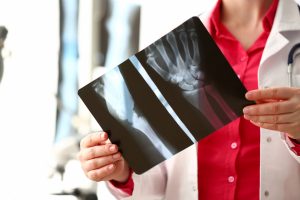 Broken bones are among the most common injuries people sustain. Over half of Americans suffer a broken bone before they turn 65. After 65, the rate of broken bones skyrockets.
Broken bones are among the most common injuries people sustain. Over half of Americans suffer a broken bone before they turn 65. After 65, the rate of broken bones skyrockets.
Most injury victims recover from a broken bone in less than two months without any long-term effects. Sometimes, however, broken bones can result in significant temporary and permanent disabilities.
Here are some facts about broken bones and the compensation you can seek for them.
What Is the Structure of Your Skeleton?

The skeleton is the foundation of the musculoskeletal system, which provides structure, strength, and movement to the body.
Your bones provide a scaffold for soft tissues like muscles, tendons, ligaments, and fascia. They’re rigid and brittle as a result of a process known as ossification. In ossification, bone cells incorporate minerals like calcium and phosphorus into a three-dimensional mesh. This mineral mesh makes bones strong but light.
Like all body cells, bones are alive. Since they require oxygen and nutrients for cell metabolism, the mesh that makes them up has blood vessels running through it. These blood vessels help the bones grow and heal.
The bones also play an important role in the circulatory system. Bone marrow produces red cells, white cells, and platelets, and the blood vessels pick up these fresh new blood cells as they run through the bones.
Bones connect at junctures called joints. Ligaments connect bones to other bones, with cartilage lining the joints to provide a smooth, strong interface between them. Tendons, meanwhile, connect bones to muscles.
The bones provide leverage and structure to help the muscles move the body. Muscles also give strength to the body when lifting, carrying, and jumping.
What Are the Causes of Broken Bones?
Broken bones occur when the bones are subject to traumatic forces powerful enough to overcome their material strength. Thicker bones have greater strength than thinner bones — the force required to break a collarbone is much less than the force needed to break your femur, the largest bone in your body.
Bones can break under a variety of forces, including:
Impacts
When a solid object strikes a bone, it can fracture it. Almost any impact can cause a fracture. For example, the impact of a car fender against your leg in a pedestrian accident could break your hip, femur, or lower leg bones.
You can also suffer a fracture when your body hits something, such as a skull fracture sustained in a slip and fall accident.
Direct Forces on the Bone
Powerful forces on a bone can fracture it. One of the most common ways this type of fracture happens is in a car accident. Your bones can eventually reach a literal breaking point as your body twists and bends in the collision.
Similarly, you could fracture a bone if one of your body parts becomes trapped and is then twisted or bent. For example, you could get your arm caught in a machine in a workplace accident, and the force of the machine could be sufficient to break one or more bones.
Overuse
Physical stress can cause small cracks to form in your bones. These cracks would ordinarily heal with rest, but repeat stresses can cause them to grow and spread instead.
Stress fractures often develop in people with jobs involving repetitive motions like lifting, carrying, and walking.
What Types of Broken Bones Can Occur?
 Broken bones are classified using terms such as:
Broken bones are classified using terms such as:
Displaced or Non-Displaced
In a non-displaced fracture, the broken ends of the bone remain aligned. In a displaced fracture, the bone fragments move out of alignment.
For the bones to heal correctly, doctors must realign them. Doctors can sometimes manipulate a displaced fracture and set the bone without surgery, but many displaced fractures require an operation to match up the ends. When doctors set a broken bone, they may use screws and plates to hold it together until it heals.
Open or Closed
Closed fractures don’t create external wounds. By contrast, open fractures happen when a bone displaces so far that it punctures the skin.
Doctors refer to a fracture that’s both displaced and open as a “compound” fracture, but fractures can displace while remaining closed.
Open fractures pose the risk of serious complications such as bleeding and infection.
The Shape of the Fracture
Bones fracture differently depending on the forces that cause them. Some types of breaks include:
Simple Fracture
In a simple fracture, the bone breaks into two pieces across its axis. Doctors must set the bone fragments if they were displaced. Then, they stabilize the bone using a cast or brace. Simple fractures usually heal within six weeks or so.
Spiral Fracture
A spiral fracture happens when a bone is twisted beyond its structural strength, causing a spiral-shaped crack to form. Doctors treat spiral fractures the same way they treat simple fractures.
Avulsion Fracture
An avulsion fracture is when a tendon or ligament gets hyperextended. Tension causes a piece of bone attached to the tendon or ligament to break off.
Doctors sometimes need to operate to repair avulsion fractures, but this isn’t necessary in many instances. Instead, they immobilize the joint and allow the fracture to heal on its own.
Comminuted Fracture
A comminuted fracture happens when a bone breaks into at least three pieces. These fractures usually result from a crushing force.
With a bone is broken into multiple pieces, the injury typically involves at least one loose bone fragment. Doctors repair this fracture by removing bone fragments and reconstructing the bone using plates and screws.
Comminuted fractures can take up to one year to heal.
How Can You Get Compensation for Broken Bones?
If you suffer broken bones in a job-related accident, you can pursue workers’ compensation regardless of how the accident happened.
Employers buy this insurance to cover employees for on-the-job injuries. When you file a claim, you stand to receive medical and partial disability benefits.
When you suffer injuries in an accident outside the workplace, you’ll generally need to prove negligence to recover compensation. If you manage to do so, you can recover compensation to cover economic losses like medical costs and lost income, as well as non-economic losses, such as pain, suffering, and disability. Contact or call Minner Vines Injury Lawyers, PLLC at (859) 550-2900 for a free consultation to discuss the compensation you can seek for your broken bones.
Minner Vines Injury Lawyers, PLLC – Lexington, KY Office
325 W Main St #210, Lexington, KY 40507
(859) 550-2900
Minner Vines Injury Lawyers, PLLC -Bowling Green, KY Office
814 State St. suite 100, Bowling Green, KY, 42101
(270) 517-2014
Minner Vines Injury Lawyers, PLLC – Nashville Office